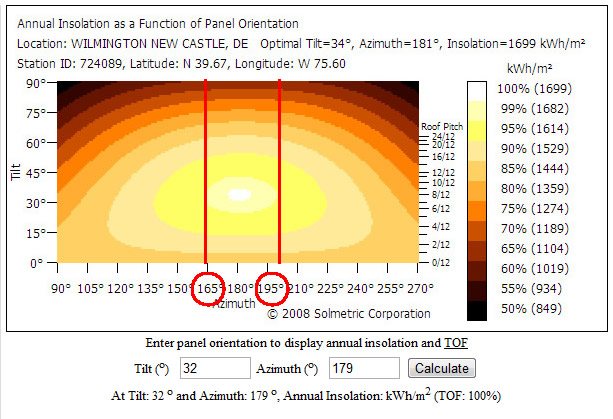
Azimuth is the array’s east-west orientation in degrees. In most of the solar PV energy calculator tools, an azimuth value of zero is facing the equator in both northern and southern hemispheres. Positive 90 degrees is facing due west, negative 90 degrees is facing due east. The compass angle shows 180 for south, 90 for east and 270 for west.
In the northern hemisphere, between the latitudes of 23 and 90, the sun is always in the south. Therefore, the modules on an array are directed to the south in order to get the most out of the sun’s energy. In the southern hemisphere, it is the opposite.
As a rule of thumb, system designers tend to use an array azimuth of zero or facing the equator; nevertheless, we should not forget the important concept of magnetic declination.


Many people are surprised to learn that a magnetic compass does not normally point to true north. This is because complex fluid currents of iron, nickel and cobalt flow near the outer core of the earth which generates a magnetic field. As a result, we need to compensate for this magnetic field.
Magnetic declination on the west coast of North America is positive while the east coast is negative. The line of magnetic declination where no adjustments are needed is approximately the Mississippi River. Any location east of the Mississippi will need to subtract the magnetic declination in order to accurately calculate the true azimuth. Conversely, any location west of the Mississippi will need to add the magnetic declination in order to accurately calculate the true azimuth.
You can calculate your magnetic declination by following this link: http://www.magnetic-declination.com/
The north facing roof is not suitable for installing solar panels in North America, whereas the east and west facing roofs could be acceptable. Usually, west facing roofs are more advantageous than east facing roofs, since the solar radiation is more powerful in the afternoon.
- The meteorological conditions of the location is an important factor to consider. For example, the insolation analysis in Hawaii shows that an array facing to the east could generate more power compared to that of an array facing south or west (see above picture). The reason could be the frequent afternoon rains in that location.
- The second factor to consider is shading. If there is a predominant morning or afternoon shade at a specific location (due to a tree, a chimney, a nearby building or a high hill in the vicinity) the azimuth angle selection could compensate for energy loss due to shading.
The same analysis was completed in a previous article; the sample 3.4 kW system consists of 16x Sanyo HIT-N215A modules, tilted 20 degrees and is located in Phoenix, AZ.
| Azimuth Angle (degrees) | Phoenix, AZ (33 North) | |
| Annual Production (kWh) | Delta (%) | |
| +90 (West) | 5,551 | -14% |
| +60 (SWW) | 6,006 | -7% |
| +45 (SW) | 6,190 | -4% |
| +20 (SSW) | 6,400 | -1% |
| 0 (South) | 6,461 | 0 |
| -20 (SSE) | 6,421 | -1% |
| -45 (SE) | 6,230 | -4% |
| -60 (SEE) | 6,053 | -6% |
| -90 (East) | 5,601 | -13% |
| 180 (North) | 4,298 | -34% |
This example shows that the optimal azimuth angle to be due south. The array on the east roof would generate slightly more energy than the one on the west roof. If the array is installed on the north facing roof, the annual energy production would be reduced up to 35%.
One solution to overcome the azimuth angle effect would be to install a solar PV system on a single-axis solar tracker. The single axis tracker system rotates about the tilted axis from the east in the morning to west in the evening to track the daily movement of the sun across the sky.
If you have any questions while creating a PV layout, don't hesitate to reach out to one of our experts or use an online software tool such as Helioscope.
Comments
Thanks for this article, I agree it is great to see this illustrative article. Why does the state of California put so much emphasis on optimal azimuth direction of due South if the loss is so small?
Usually, that dip is due to atmospheric particles or pollution. The daylight might be longest on June 21-22, but the air is usually less clear than in spring or fall. It may also be that they aren't normalizing for temperature - the high temps of July and August could also cause that dip if they are reading straight output.
Can horizontal single axis trackers like https://scorpiustrackers.com/ help to improve it?
Not sure what the author meant by "Usually, west facing roofs are more advantageous than east facing roofs, since the solar radiation is more powerful in the afternoon."
Assuming cloud-free skies all day, the solar radiation in most areas would normally be stronger in the morning, because atmospheric haze, water vapor, and pollution (smog, various particulates) all increase in the afternoon to block sunlight. Further, the afternoon temperatures are typically higher than those in the morning and silicon solar cells are less efficient at higher ambient temperatures.
how Delta is calculated for particular location., Any formula?
Delta was calculated as a function of lost production from an optimal solar azimuth using the Perez model, see a citation from the related articles.
“The Perez model is used for the calculations. See Perez, R.; Ineichen, P.; Seals, R.; Michalsky, J.; Stewart, R. (1990). "Modeling Daylight Availability and Irradiance Components from Direct and Global Irradiance." Solar Energy, 44(5), pp. 271-289.”
Thanks again for the question.